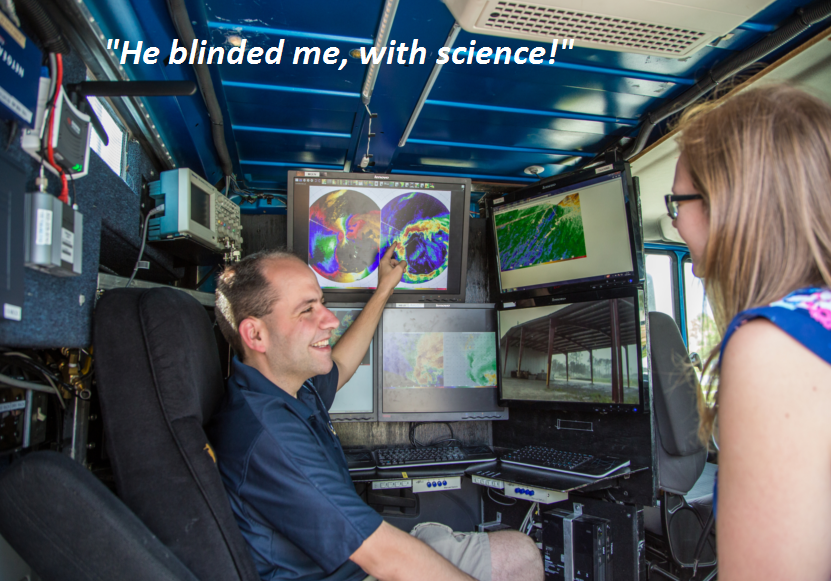Undergraduate courses that I currently teach regularly
WX 201: SURVEY OF METEOROLOGY
This is a survey course in atmospheric science. Included is a systematic development of the following: thermal patterns, atmospheric moisture, horizontal and vertical pressure patterns, clouds, atmospheric circulation, local winds, stability, air masses, fronts, fog, icing, thunderstorms, jet streams and turbulence. Students will study and make use of surface weather observations, sea-level pressure charts, and isobaric charts.
Current weather discussions are included in class periods as exciting weather dictates.
Fall 2024 Syllabus
WX 327: oPERATIONAL ANALYSIS AND FORECASTING
This course introduces weather analysis and forecasting using conceptual understanding of observations and synoptic-scale processes. Meteorological time and date conventions; surface station plots; METAR code; upper-air station plots; isoplething; basic satellite and radar feature identification; temperature and vorticity advection; vorticity, divergence, and continuity; advection and relationship to vertical motion; skew-T analysis; types of soundings; meteorological case study.
My textbook is used for this course.
Spring 2025 SYLLABUS
WX 378: Synoptic analysis
This is the first required course in synoptic meteorology. Forecast tools (NWP output, NBM, human forecast products, etc.; forecast techniques; National Weather Service (NWS) products and services; cross-section analysis; fronts, jets, and thermal wind; continuity equation and vertical motion; precipitation type forecasting; thermodynamic equation and temperature advection solenoids; vorticity equation and vorticity advection solenoids; barotropic vorticity equation.
Students produce regular 7-day forecasts for the ERAU Campus and also participate in the WxChallenge.
Spring 2025 SYLLABUS
WX 466: Advanced Synoptic analysis and forecasting
This is the second required course in synoptic meteorology. Produce regular oral and written forecast discussions for various hazards (TCs, flash flood, severe/fire weather, winter weather, etc.); equations and applications of Quasi-Geostrophic (QG) theory; Potential Vorticity (PV) thinking and applications; isentropic analysis and applications; blind forecast case studies.
Students produce regular 7-day forecasts for the ERAU Campus.
FALL 2024 SYLLABUS
Undergraduate courses that I have taught in the past
WX 301: Aviation Weather
This course is an expansion of WX 201 with a focus on aviation weather hazards, including convective hazards (thunderstorms, hail, high winds), non-convective weather hazards (fog, icing, turbulence, wind shear, winter weather), and special weather hazards (volcanic ash and space weather). Meteorological concepts such as pressure, atmospheric forces, thickness, thermal wind, fronts, jet streams, cyclone formation, and atmospheric stability are expanded and applied to aviation operations. Emphasis is on navigating today's online environment for obtaining and analyzing real-time surface observations, upper-air observations, satellite data, and radar data, as well as both primary and supplementary aviation weather products.
WX 340: Severe Weather Field Forecasting (some Summers)
We tried to call it storm chasing, but the lawyers wouldn’t allow it. This course has been run on occasion (last time in Summer 2022) through the ERAU Office of Global Engagement. See pictures from previous course offerings on my Storm Chasing page.
Summer 2022 SYLLABUS
WX 381: Climate dynamics
This is a primarily quantitative course on the physical and dynamical processes of climate, climate variability, and climate change. It is currently taught at ERAU by Dr. Sarah Strazzo. These were the topics when I have taught it in the past: Atmospheric general circulation and relation to climate; climate sensitivity and feedback mechanisms; atmosphere-ocean interaction and coupling; El Nino and Southern Oscillation; atmospheric teleconnections; seasonal and long-range weather forecasting; climate modeling and climate model simulations; internally-forced (natural) climate variability; externally-forced (anthropogenic) climate change; quantitative understanding of future climate scenarios; review of Intergovernmental Panel on Climate Change (IPCC) report.

